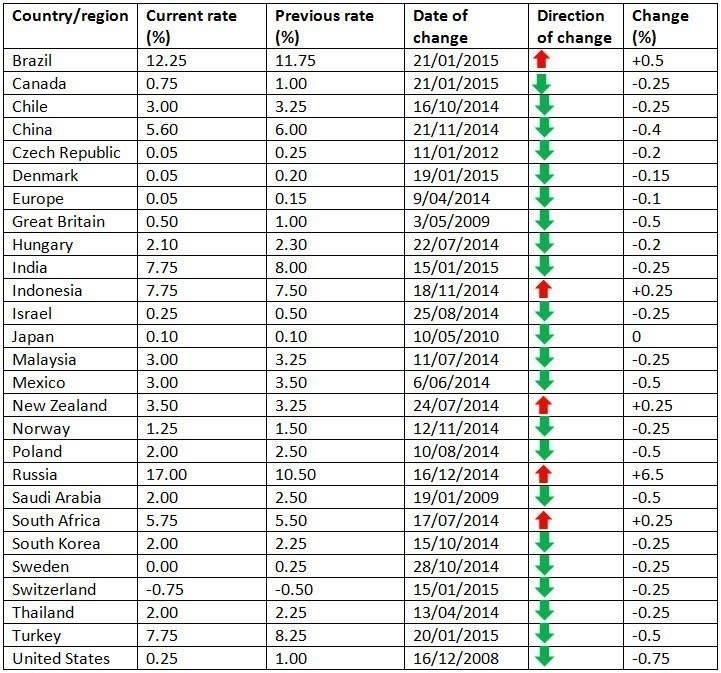What central banks around the world are doing with interest rates
There was little consensus on what the next move for interest rates in Australia was.
Several economists have changed their predictions from flat or rising rates through 2015 to forecasts of declines, while others maintain that the next shift will be up.
A key financial market indicator, the ASX 30 Day Interbank Cash Rate Futures February 2015 contract, on 27 January revealed a 38% expectation of an interest rate cut to 2.25% at the RBA’s board meeting on 3 February. But, with the release of higher than anticipated inflation data for the final quarter of 2014 on 28 January, the indicator dropped sharply to 16%, suggesting much lower expectations of a rate cut in February.
Click to open in new window:
Source: global-rates.com, Property Observer research.
Some economists, including HSBC Bank’s chief economist for Australia and New Zealand Paul Bloxham, say the latest inflation figure means interest rates are now more likely to remain on hold through 2015 than be cut.
The RBA bases its interest rate decisions on a wide range of economic drivers. Local inflation figures are a critical component. But global economic factors such as falling oil prices and uncertainty in the economic outlook for Australia’s trading partners and other countries also have an influence.
Property Observer had a look at what central banks in other countries are doing with their official interest rates.
The RBA bases its interest rate decisions on a wide range of economic drivers. Local inflation figures are a critical component. But global economic factors such as falling oil prices and uncertainty in the economic outlook for Australia’s trading partners and other countries also have an influence.
Trading partners
China is Australia’s biggest two-way trading partner so its economic health is vital to Australia. China’s economy has been slowing and in November 2014 its central bank cut interest rates for the first time in two years in move to improve the situation. Its official interest rate is now at 5.6%, down from 6% in November.
Australia’s second largest trading partner is Japan. The Japanese economy has been in a poor state for years. Its official interest rate is just 0.1%.
The Federal Reserve, the central bank of Australia’s next biggest trading partner, the USA, has been vocal about its intentions to keep rates low for the near term. Its interest rate has been at 0.25% since December 2008, when the Fed slashed rates from 1%.
The table below shows the current interest rates of several major countries, the previous interest rate and the date of the most recent change.
As the table shows, many countries have been lowering interest rates. Most recently, at the end of January, Canada surprised markets by cutting rates, while Switzerland further lowered its negative interest rate, so customers must pay more to the central bank for holding their money.
Only a handful of countries have boosted rates in recent months, one being New Zealand, which is another of Australia’s top 10 trading partners. New Zealand lifted its interest rate in July last year to 3.5%.
While many countries manage monetary policy through interest rates, Singapore, another of Australia’s most important trading partners, manages its foreign exchange rate instead. On 28 January, the Monetary Authority of Singapore surprised the market by saying it would take measures to slow the rise of its dollar. This could be considered its version of cutting interest rates.

